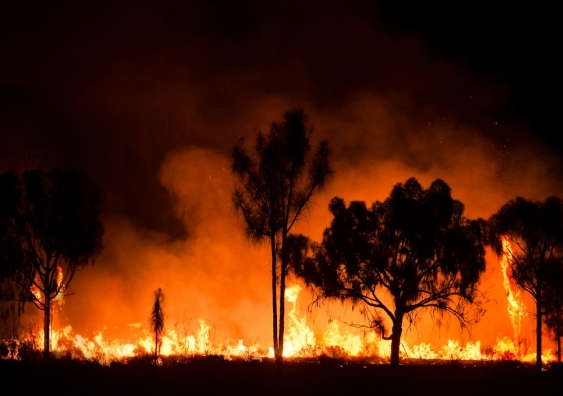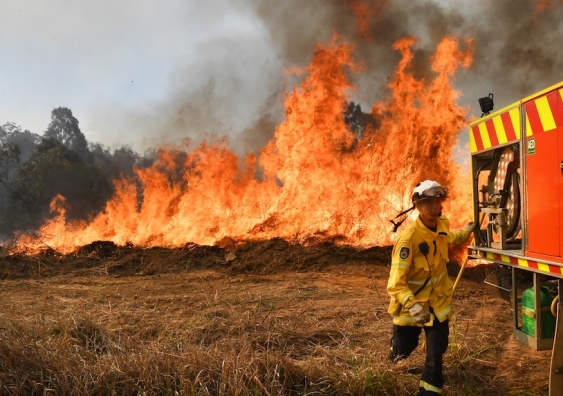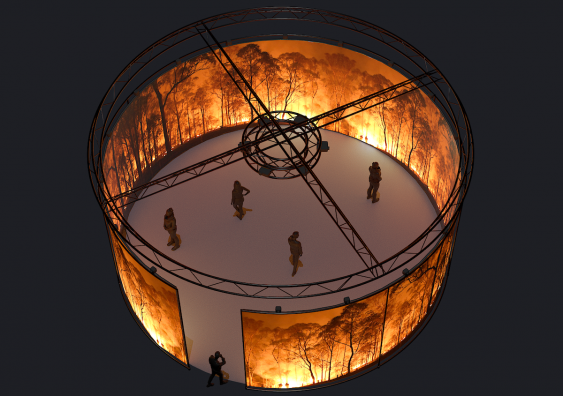Cutting-edge immersive disaster simulation and training systems will be created for NSW’s firefighters.
Fire and Rescue NSW (FRNSW) have entered into a five-year agreement with researchers from UNSW’s iCinema Research Centre to create a fully immersive bushfire visualisation system to allow fire and rescue personnel to experience the behaviour of fires in virtual scenarios.
UNSW has invested more than $35 million in multiple artificial intelligence (AI) powered immersive simulation systems, which researchers will now customise to create trailblazing education and training experiences for FRNSW.
The project has leveraged large-scale Australian Research Council (ARC) funding in creative visualisation since 2002, most recently a Laureate Fellowship, to explore unpredictable fire scenarios.
Under the partnership, the University is providing FRNSW with a 3D Immersive Cinema worth $250,000 that will allow firefighters and incident commanders to fully immerse and interact in simulated emergency scenarios.
The project team will install the iFire system at FRNSW Emergency Training Academy Orchard Hills’ premises.
Media enquiries
Louise Templeton
Corporate Communications Officer
�ձ��:��+61413495994
����������:��louise.templeton@unsw.edu.au
NSW Minister for Emergency Services the Hon. Jihad Dib said the partnership allowed for an innovative approach to response training and preparedness.
“FRNSW is leading the way in the education and training space by exploring opportunities that overcome the challenges of distance,” Minister Dib said.
“This technology can effectively put our firefighters in the centre of a simulated fireground or other emergency, allowing them to develop important incident response skills and prepare for the real thing.”
Vice-Chancellor and President of UNSW Sydney, Professor Attila Brungs said UNSW was proud to be partnering with FRNSW in this innovative use of immersive technology.
“The collaboration between UNSW and FRNSW to develop iFire to create immersive training modules is set to enhance the skills of our first responders, which will be of great benefit to our communities,” Prof. Brungs said.
“We also look forward to the progress this frontline research will bring to firefighting techniques and emergency decision making.”
FRNSW Commissioner Jeremy Fewtrell AFSM said the partnership cemented FRNSW as an industry leader in the applied research space.
“The technology has been successfully utilised in underground mining applications, and we intend to use it to better understand the dangers of bushfires and urban incidents,” Commissioner Fewtrell said.
“The technology will also allow our people to practice their incident command and response when it comes to large-scale emergencies.”
What does iFire do?
Building on technology that translates Data61’s SPARK simulation system and the WRF_SFIRE system, iFire creates immersive 3D environments using visualisations developed by UNSW’s Scientia Professor Dennis Del Favero, ARC Laureate Fellow and Executive Director of the iCinema Research Centre.
The project recreates three real-world case studies: a pine-plantation fire, a grass fire, and the unprecedented and unpredictable 2020 US Bridger Foothills Fire.
“In each of these scenarios, users will be able to adjust variables to experience in real-time the influence of changes in factors for wind speed, fuel load and temperature on the behaviour of fire,” said Prof. Del Favero.
The system allows groups of commanders and firefighters to immerse themselves in high-fidelity real-world fire landscapes ... and more effectively prepare for their unpredictable and life-threatening behaviour.
Immersive training saves lives and reduces injury
The collaboration builds on the award-winning iCASTS mine immersive training system, developed with the NSW Government, mining unions and Mines Rescue, that saved lives and reduced serious injury by 65% across Australian mine sites by exposing miners and planners to known underground threats.
Using AI, iFire establishes the next generation in immersive visualisation by enabling incident commanders and firefighters to engage with unanticipated fireground threats.
“The system allows groups of commanders and firefighters to immerse themselves in high-fidelity real-world fire landscapes using the film industry standard UNREAL visualisation engine,” said Prof. Del Favero.
“By changing environmental variables in the virtual scenario, such as the rise in temperatures brought on by global warming, they can experience the look and feel of extreme fires and more effectively prepare for their unpredictable and life-threatening behaviour.”
Looking to the future
As it is developed further, the iFire system will ultimately enable firefighters on any screen device in any location to sensorially experience the look and feel of a possible near-future scenario as if they are present.
“Importantly, this will allow firefighters, for the very first time, to interactively anticipate, practice and implement preparedness as a team-based experience, to minimise immediate risk and optimise strategic resilience,” said Prof. Del Favero.
--------------------------------------------------------------------------------------------------------------------------------------------------------------
The iCinema Research Centre focuses on the development of creative AI visualisation to experientially address unpredictable scenarios such as extreme fires and floods.
Prof. Del Favero and colleagues have just published the book Climate Disaster Preparedness: Reimaging Extreme Events through Art and Technology, which explores best practices in digital arts, intelligent systems and climate science to address global climate challenges. The book is open access and is available at
Related stories
-

In a bad fire year, Australia records over 450,000 hotspots. These maps show where the risks have increased over 20 years
-

It's time to rethink Australia's fire management strategies
-

Artificially intelligent visualisation artistically re-imagines wildfires
-

Coastal storms: national early warning system will help us better prepare for beach erosion and flooding






